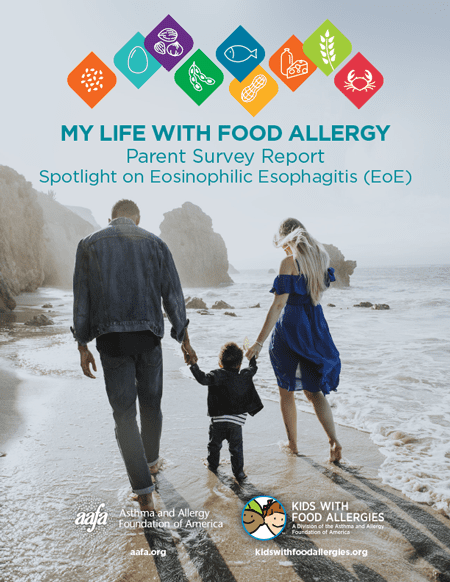Allergies
Food Allergy
A food allergy occurs when the body’s immune system sees a certain food as harmful and reacts by causing allergic symptoms. Foods that cause allergic reactions are allergens.
More than 20 million American adults and children have food allergies.1,2 We commonly hear about children with food allergies. But people can develop a food allergy at any age. Many adults develop food allergies even without a prior history of allergies.
There is no cure for food allergies. The only way to prevent an allergic reaction is to avoid the food you are allergic to. The good news is with the right steps, you can manage your food allergies and live a full life.
There are different types of allergic reactions to foods:
- Immunoglobulin E (IgE) mediated. The body’s immune system makes antibodies called immunoglobulin E (IgE). These IgE antibodies react with a certain food and cause symptoms. In the U.S., the most common causes of food allergy are these nine foods:
- Non-IgE mediated. Other parts of the body’s immune system react to a certain food. This reaction causes symptoms but does not involve an IgE antibody. Someone can have both IgE mediated and non-IgE mediated food allergies.
Not all people who react to a certain food have an allergy. They may have a food intolerance. Examples are lactose intolerance, gluten intolerance or sulfite sensitivity. Food intolerance does not involve the immune system.
There are three basic principles to managing food allergies.
Closed
Drug Company Assistance Programs
The medicines covered by the programs below may change at any time. The following medicines are covered as of Jan. 24, 2025.
Company:
- AstraZeneca
Medicines offered:
- AIRSUPRA®
If you have commercial insurance: If you have employer-provided or individual private (commercial) insurance, you may be able to get AIRSUPRA for as low as $0 with the SUPRA Savings Card.
If you have government insurance: For people with Medicare Part D coverage, the average out-of-pocket cost is $89 per month. For people with Medicaid, the out-of-pocket costs range from $.99-$13 per month. Some states offer even lower copays or eliminate the copay altogether. If you have Medicare Part D and cannot afford AIRSUPRA, you may be eligible for the patient assistance program, AZ&Me.
If you have no insurance: If you do not have health insurance or your insurance does not cover AIRSUPRA, you will pay the amount determined by your pharmacy. You may also be eligible for the patient assistance program, AZ&Me.
Learn more on the Cost Assistance with AIRSUPRA website or call 866-480-0030.
Company:
- AstraZeneca
Medicines offered:
- BEVESPI AEROSPHERE®
- BREZTRI AEROSPHERE®
- SYMBICORT®
- FASENRA®
- TEZSPIRE®
If you have commercial insurance, government insurance, or no insurance:
AstraZeneca US Patient Support offers various savings for several of their medicines. They offer copay savings cards and patient assistance programs depending on what type of insurance you have.
For more information, visit AZPatientSupport or call 800-236-9933.
AstraZeneca has capped the cost of their inhalers to $35 if you have commercial or private insurance. Learn more about the price cap.
Company:
- AstraZeneca
Medicines offered:
- TEZSPIRE®
If you have commercial insurance: The TEZSPIRE Together Co-Pay Program can help may help you save regardless of income if you qualify. Get doses for as little as $0 and up to $100 off your in-office administration costs (pre-filled syringe only). Learn more on the TEZSPIRE Together Co-Pay Program website or call 888-987-7473.
If you have government insurance: The TEZSPIRE Together Program, you may be able receive TEZSPIRE at no cost if you qualify. This includes people who:
- Are uninsured
- Have Medicare Part B with no supplemental insurance
- Have a Medicare Advantage plan with an affordability gap
- Have insurance that does not cover TEZSPIRE
For more information, call 888-987-7473.
Company:
- Boehringer Ingelheim
Medicines offered:
- Atrovent® HFA
- Combivent® Respimat®
- Spiriva® Respimat®
- Stiolto® Respimat®
- Striverdi® Respimat®
If you have commercial insurance or don’t have insurance: If you qualify, your cost will automatically be discounted when you buy these inhalers at participating retail pharmacies. If your cost is more than $35, download and use a savings card. Learn more at: InhalerOffer.com
If you have government-funded insurance: If you use Medicare, Medicaid, CHIP, or TRICARE, visit the Boehinger Cares Patient Assistance Program webpage or call 800-556-8317 to apply for assistance.
Boehringer Ingelheim has capped the cost of their inhalers to $35 if you have commercial or private insurance. Learn more about the price cap.
Company:
- Sanofi and Regeneron Pharmaceuticals, Inc.
Medicines offered:
- DUPIXENT®
If you have commercial insurance: The Dupixent MyWay® Copay Card may help you lower the cost of your copay. Learn more on the Dupixent MyWay Copay Card website or call 844-DUPIXENT (844-387-4936), option 1.
If you don't have insurance or your insurance doesn’t cover Dupixent: You can apply for the DUPIXENT MyWay Patient Assistance Program. For more information or to sign up, call 844-DUPIXENT (844-387-4936), option 1.
If you have Medicare: At this time, there is not a savings program for Dupixent if you have Medicare. Call 844-DUPIXENT (844-387-4936), option 1 for more information.
If you have Medicaid: Your copay and coverage may vary depending on what state you live in. If you meet the criteria, you may also be able to get help from the DUPIXENT MyWay Patient Assistance Program. For more information or to sign up, call 844-DUPIXENT (844-387-4936), option 1.
Medicines covered:
- Epinephrine devices – all brands
Savings programs:
- See AAFA’s list of all available epinephrine devices and their patient assistance programs.
Company:
- Genentech
Medicines offered:
- Xolair®
If you have commercial insurance: Genentech offers a copay savings program for Xolair. You may also be able to get help from an independent copay assistance foundation. ![]()
If you have government insurance or don’t have insurance: You may be able to get help from an independent copay assistance foundation. Find programs. ![]()
Company:
- GSK (GlaxoSmithKline)
Medicines offered:
- ARNUITY ELIPTA
- ANORO ELLIPTA
- BREO ELLIPTA
- INCRUSE ELLIPTA
- NUCALA®
- SEREVENT®
- TRELEGY®
If you have commercial insurance: You may be eligible for the GSK Copay Assistance Program.
If you have Medicare or no insurance: You may qualify for the GSK Patient Assistance Program. This program can help you receive certain GSK prescription medicines and vaccines at no cost.
For more information, visit GSK Patient Assistance Program & Savings Offers or call 888-825-5249.
GSK has capped the cost of their inhalers to $35 if you have commercial or private insurance. Learn more about the price cap.
Company:
- GSK (GlaxoSmithKline)
Medicines offered:
- NUCALA®
If you have commercial insurance: If you have a commercial medical or prescription insurance plan, you may be able to take part on the NUCALA Copay Program. If you are approved, the GSK Copay Program may help with your cost share for NUCALA and the your cost share for administration up to the total annual copay program maximums.
If you have government insurance or no insurance: You are not eligible for this program if you are covered by any federal or state prescription insurance program.
For more information, visit the NUCALA Copay Program website or call 800-691-1939.
Company:
- Organon
Medicines offered:
- ASMANEX® HFA
- ASMANEX® TWISTHALER®
- DULERA®
If you have commercial insurance: If you qualify, you may be able to save with an ASMANEX Multiuse Savings Coupon.
If you qualify, you may pay as little as $15 per Dulera prescription on each of up to 12 qualifying prescriptions. The maximum savings is $90 per prescription.
If you have government insurance or no insurance: At this time, there is no assistance program if you have Medicaid or Medicare.
Company:
- Teva
Medicines Covered:
- QVAR RediHaler®
- CINQAIR®
Teva Cares Patient Assistance Program provides certain Teva medicines at no cost if you live in the United States and meet specific insurance and income criteria. Learn more about program eligibility.
If you do not meet the eligibility requirements for the Teva Cares Foundation Patient Assistance Programs, you may be eligible for help from other programs they offer.
For more information, visit the Teva Cares Foundation website or call 888-838-2872.
Pharmacy Drug Savings Programs
Program Name:
Contact Information:
- 844-265-6444
- moc.htlaehknilb@ofni
About the Program:
- Blink Health finds the lowest price for the medicines you need. Find discounted prescription prices on more than 15,000 medicines.
Program Name:
Contact Information:
- 844-926-2480
- moc.xrknilb@troppus
About the Program:
- BlinkRx is a digital pharmacy service that carries certain medicines. They can provide the lowest prescription price while providing free home delivery.
Program Name:
Contact Information:
- 855-268-2822
About the Program:
- GoodRx is a free resource that lets you compare medicine prices and find discounts.
Looking for savings on asthma inhalers? See the GoodRx Savings Guide for ways you may be able to save money on 25 asthma inhalers.
Program Name:
Contact Information:
- 833-317-2937
About the Program:
- The Kroger Health Savings Club is an annual membership program that entitles members to reduced prices on prescription drugs.
Program Name:
Contact Information:
About the Program:
- Mark Cuban CostPlus Drug Company offers access to affordable medicines at the lowest possible price. Learn about program eligibility.
Program Name:
Contact Information:
- 888-331-1002
About the Program:
- The SCBN Prescription Assistance program is for uninsured or underinsured people who cannot afford their prescribed medicines.
- The program requires a membership fee to participate.
Program Name:
Contact Information:
- Contact your local Walmart pharmacy
About the Program:
- The Walmart low-cost Prescription Program includes up to a 30-day supply for $4 and a 90-day supply for $10 of some covered generic drugs at commonly prescribed dosages. Prices for some drugs covered by the program may vary by state.
Program Name:
Contact Information:
- 877-296-4673
About the Program:
- Prescription Hope provides access to brand-name medicines for only $60 a month per medication through their medication access service. Learn about program eligibility.
Nonprofit Copay and Premium Assistance Programs
Organization:
Contact Information:
- 800-511-5144 (TTY 711)
- moc.htlaehairaca@eracremotsuc
About the Program:
- AcariaHealth provides specialty pharmacy services for people living with complex and chronic health conditions. Their Copay Assistance Support Team will research and apply to qualifying patient assistance programs on behalf of the patient. Learn about the program.
Organization:
Contact Information:
- 800-366-7741
About the Program:
- Accessia Health provides financial help to pay for copays, health insurance premiums, travel costs, and other medical expenses. Learn about program eligibility.
Organization:
Contact Information:
- 877-968-7233
About the Program:
- Good Days provides financial support for people who cannot afford the treatment they urgently need.
- Copay, travel, premium, and diagnostic testing assistance may be available.
- Learn about eligibility criteria.
Organization:
Contact Information:
- 980-859-3483
- gro.htaprobrah@ofni
About the Program:
- Harbor Path delivers lifesaving medicine for free to people who are uninsured. They currently serve 24 states. Use the eligibility calculator to see if you qualify.
Organization:
Contact Information:
- 800-675-8416
- gro.noitadnuofllewhtlaeh@stnarg
About the Program:
- HealthWell Foundation provide financial assistance to help with prescription copays, travel costs, behavioral health services, health insurance premiums, deductibles, and copays. Please note that diseases covered may change from time to time.
Organization:
Contact Information:
- 866-316-7263
About the Program:
- The PAN Foundation offers financial help for out-of-pocket medicine costs including copays, health insurance premiums, and transportation costs related to medical care. Learn about program eligibility. Please note that diseases covered may change from time to time.
Organization:
Contact Information:
- 866-512-3861
About the Program:
- PAF’s Co-Pay Relief (CPR) program provides direct financial help to qualified people with co-payments, co-insurance or cost-sharing associated with prescription drugs through funds for specific disease states. Learn about program eligibility. Please note that diseases covered may change from time to time.
Organization:
Contact Information:
- 800-769-3880
About the Program:
- Rx Outreach provides discounted medicines for eligible people. Learn about the program.
Organization:
Contact Information:
- 855-845-3663
About the Program:
- TAF helps people and families by providing them with financial help for their copays, coinsurance, premiums, deductibles, and other health-related expenses.
Patient Assistance Tools and Databases
Tool:
- BenefitsCheckUp® – National Council on Aging
Contact Information:
- 800-794-6559
More Information:
- BenefitsCheckUp® is a free service of the National Council on Aging (NCOA). It is an online tool to connect older adults and people with disabilities to benefit programs such as health care, medicine, food, utilities, and more.
Tool:
Contact Information:
- 615-736-5075
- gro.epohfoyrasnepsid@ofni
About the Program:
- Dispensary of Hope provides medicine to communities, free of cost. They are a charitable medication distributor dedicated to providing pharmacies and clinics with reliable access to medication that was generously donated by pharmaceutical manufacturers. Find a dispensing site near you, here.
Tool:
Contact Information:
- 800-503-6897
- gro.sdemydeen@ofni
More Information:
- A national nonprofit that connects people to programs that may help them afford their medicines and other health care costs.
Tool:
- PhRMA’s Medicine Assistance Tool (MAT) – Partnership for Prescription Assistance
Contact Information:
- 571-350-8643
More Information:
- PhRMA’s Medicine Assistance Tool (MAT) is a search engine for many patient assistance resources offered by drug makers.
Tool:
Contact Information:
More Information:
- RxAssist offers a comprehensive database of patient assistance programs. Learn about the eligibility requirements.
Tool:
Contact Information:
- 844-234-3057
- moc.eracelgnis@troppus
More Information:
- SingleCare works with pharmacies on discounts on prescriptions. Look up prescriptions to find the lowest prices in your area.
Tool:
Contact Information:
- 800-719-5147
- moc.esnesxr@rednifsgnivasxr
About the Program:
- Walgreens Rx Savings Finder can help you find prescription discount cards that can help you find the lowest price on a medicine at Walgreens.
State Drug Assistance Programs
Organization:
- Extra Help – Social Security Administration
Contact Information:
- 800-772-1213
- (TTY 800-325-0778)
More Information:
- The Extra Help program helps people with limited income and resources lower or cut Medicare Part D costs.
Organization:
- State Health Insurance Assistance Programs (SHIPs) – National Technical Assistance Center
Contact Information:
- 877-839-2675
- gro.htlaehpihs@ofni
More Information:
- Free insurance counseling and help to Medicare-eligible people, their families, and caregivers.
Organization:
Contact Information:
- Contact your local county office.
More Information:
- CalAIM offers people on Medi-Cal access to services that address physical, behavioral, developmental, dental, and long-term care needs.
Organization:
- State Pharmaceutical Assistance Program – Medicare.gov
More Information:
- Find out if your state has a state pharmaceutical assistance program.
Organization:
- Pharmaceutical Assistance Program – Medicare.gov
More Information:
- Learn more about pharmaceutical companies that offer programs to help pay for prescriptions for people with a Medicare Drug Plan (Part D).
Community Resources
American Sleep Apnea Association: Assists people with sleep apnea who cannot afford their CPAP mask supplies through the CPAP Assistance Program.
Friends of Man: Receives applications for mobility equipment, prosthetics, home modifications, medical equipment, hearing aids, basic needs and much more. The referral must be made by a professional. This includes caseworkers, case managers, health care workers, social workers, school counselors, teachers, and clergy.
FoodFinder: A map of food pantries across the United States. Search your ZIP code to learn about free food assistance programs near you.
FundFinder: Helps you find financial assistance from charitable foundations.
Inspira Financial: Funds in a health savings account (HSA) or a health care flexible spending account (FSA) can be used for eligible medical expenses.
Society of St. Vincent de Paul: A national non-profit that provides local assistance and services.
United Way 211: The most comprehensive source of information about local resources and services in the country.
AAFA Regional Chapters
The AAFA New England Chapter has more information on drug assistance for Massachusetts residents.
The AAFA Michigan Chapter has more information on drug assistance for Michigan residents, including the Jared Williams Medication Fund (JWMF).
Visit our food allergy division – Kids with Food Allergies:
- Learn more about food allergies
- Find allergy-friendly recipes
- Connect with parents managing their children’s food allergies
- Get information about managing food allergies in schools
Medical Review: December 2022 by Michael Pistiner, MD, MMSc
References
1. Ng, A.E. & Boersma, P. (2023). NCHS Data Brief, no 460: Diagnosed allergic conditions in adults: United States, 2021. National Center for Health Statistics. https://dx.doi.org/10.15620/cdc:122809
2. Zablotsky, B., Black, L.I., & Akinbami, L.J.(2023). NCHS Data Brief, no 459: Diagnosed allergic conditions in children aged 0-17 years: United States, 2021. National Center for Health Statistics. https://dx.doi.org/10.15620/cdc:123250

KFA is dedicated to saving lives and reducing the burden of food allergies through support, advocacy, education and research.














